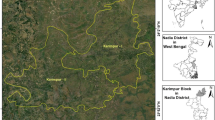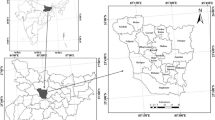Abstract
Spatial interpolation technique is useful for spatial mapping with sparse data procured from vantage in situ sampling sources. Through spatial interpolation, wall-to-wall mapping of the arsenic concentration in groundwater was accomplished for the whole of the study area by using known concentration value at nearby locations (aquifers) under homogenous terrain conditions. This present study proposes an empirical methodology through interpolation approach for spatial mapping of seasonal and annual groundwater arsenic contamination in the district North 24 Parganas, which happens to be the one of the worst arsenic-affected districts of West Bengal, India, in Bengal Basin. Two types of interpolation approach, Thiessen polygon and Kriging, have been used for spatial mapping of arsenic distribution. On the basis of spatial distribution map, classification has been done for the entire district into seven arsenic concentration zones with various levels of contaminations from arsenic in groundwater (0.01 mg/L as WHO-declared maximum limit for safe zone). In this study, a total of six seasonal (pre-/post-monsoon) data from 2006 to 2008 have been interpreted to examine temporal changes of arsenic concentration in groundwater, and finally, the future trend is projected. Future trend assessment of arsenic contamination has been performed through statistical analysis fitting a linear regression equation. Through this study, it is revealed that the unaffected blocks in the pre-monsoon season (March–April–May) of year 2006 became significantly affected by the end of year 2008. From regression model, it has been predicted that if this trend continues, then, after ten years 2/3 blocks of the said districts will be arsenic affected.










Similar content being viewed by others
References
Burrough, P. A. (1986). Principles of geographical information systems for land resources assessment. New York: Oxford University Press.
Chang, Kt. (2002). Introduction to geographical information systems. India: Tata McGraw Hill.
Chowdhury, M., Alouani, A., & Hossain, F. (2010). Comparision of ordinary kriging and artificial neural network for spatial mapping of arsenic contamination of groundwater. Stochastic Environmental Research and Risk Assessment,24, 1–7.
Davis, J. C. (1996). Statistics and data analysis in geology. New York: Wiley.
Deutsch, C., & Journel, A. (1998). GSLIB: Geostatistical software library and user’s guide (p. 340). Oxford: Oxford University Press.
Ghosh, M., Pal, D. K., & Santra, S. C. (2012). Different land use and other physical and socio-economic parameters in ground water arsenic concentration. International Journal of Science & Emerging Technologies,3, 89–101.
Goovaerts, P., AvRuskin, G., Meliker, J., Slotnick, M., Jacquez, G., & Nriagu, J. (2005). Geostatistical modeling of the spatial variability of arsenic in groundwater of southeast Michigan. Water Resources Research,41, W07013.
Groundwater Arsenic Contamination in West Bengal-India (20 years study). www.soesju.org. Accessed May 2009.
Heine, G. W. (1986). A controlled study of some two-dimensional interpolation methods. COGS Computer Contributions,3(2), 60–72.
Kinniburg, D. G., Smedley, P. L. (2001). Arsenic contamination of groundwater in Bangladesh. Ministry of Local Government, Rural Government and Cooperatives, Government of Bangladesh, BGS Technical Report WC/00/19 (Vol 1).
Levin, R. I., Rastogi, S., Rubin, D. S., & Siddiqui, M. H. (2013). Statistics for management. Delhi: Dorling Kindersley pvt. Ltd.
McBratney, A. B., & Webster, R. (1986). Choosing functions for semi-variograms of soil properties and fitting them to sampling estimates. Journal of Soil Science,37, 617–639.
Oliver, M. A. (1990). Kriging: A method of interpolation for geographical information systems. International Journal of Geographic Information Systems,4, 313–332.
Press, W. H., Teukolsky, S. A., Vetterling, W. T., & Flannery, B. P. (1988). Numerical recipes in C/; The art of scientific computing. New York: Cambridge University Press.
Royle, A. G., Clausen, F. L., & Frederiksen, P. (1981). Practical universal Kriging and automatic contouring. Geoprocessing,1, 377–394.
Schwartz, R. A. (1997). Arsenic and the skin. International Journal of Dermatology,36, 241–250.
Sibson, R. (1981). A brief description of natural neighbor interpolation (pp. 21–36)., Chapter 2 in interpolating multivariate data New York: Wiley.
Tareq, S. M., Safiullah, S., Anawa, H. M., Rahman, M. M., & Ishizuka, T. (2003). Arsenic pollution in groundwater: A self- organizing complex geochemical process in the deltaic sedimentary environment, Bangladesh. Science of the Total Environment,313, 213–226.
The World Bank. (2005). Environment and social unit—South Asia region, water and sanitation programme (WSP) South and East Asia. Arsenic Contamination of Groundwater in South and East Asian Countries. Volume II Technical Report No. 31303.
Tseng, T., Babazono, A., Yamamoto, E., Kurumatani, N., Mino, Y., Ogawa, T., et al. (1968). Ingested arsenic and internal cancer in an endemic area of chronic arsenicism in Taiwan. Journal of the National Cancer Institute,40, 453–463.
Watson, D. (1992). Countouring: A guide to the analysis and display of spatial data. London: Pergamon Press.
WHO. (2001). Environmental health criteria. Geneva, 224, Arsenic and Arsenic Compounds.
Acknowledgements
We would like to thank SWID (State Water Investigation Directorate, Govt. of West Bengal, India) for chemical testing of data samples and providing arsenic concentration value of each sample. It is a great pleasure to acknowledge Dr. Pijush Kanti Jana, Head of the Dept. of Library and Information Science, Vidyasagar University, who guided us to make related statistical analysis of this research study by allotting us valuable time from his very busy schedule.
Author information
Authors and Affiliations
Corresponding author
Additional information
Publisher's Note
Springer Nature remains neutral with regard to jurisdictional claims in published maps and institutional affiliations.
Electronic supplementary material
Below is the link to the electronic supplementary material.
Rights and permissions
About this article
Cite this article
Ghosh, M., Pal, D.K. & Santra, S.C. Spatial mapping and modeling of arsenic contamination of groundwater and risk assessment through geospatial interpolation technique. Environ Dev Sustain 22, 2861–2880 (2020). https://doi.org/10.1007/s10668-019-00322-7
Received:
Accepted:
Published:
Issue Date:
DOI: https://doi.org/10.1007/s10668-019-00322-7




